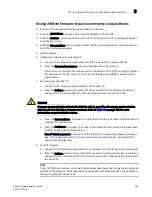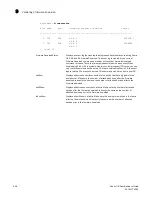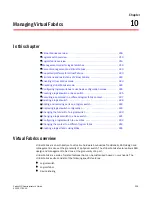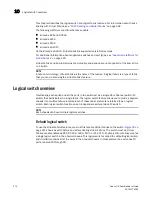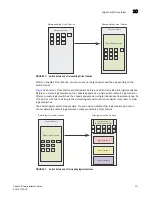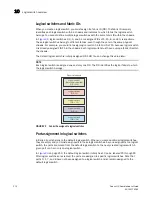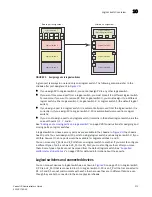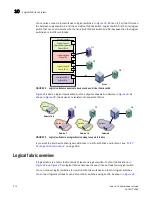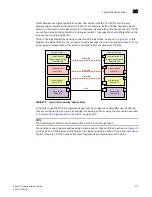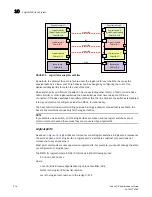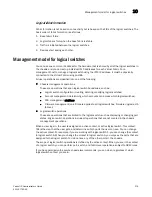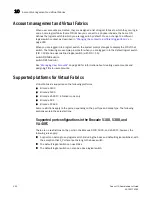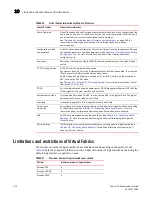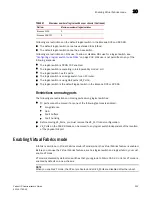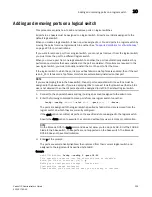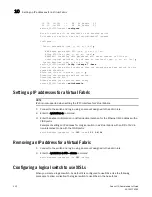
Fabric OS Administrator’s Guide
219
53-1001763-02
Management model for logical switches
10
Logical fabric formation
Fabric formation is not based on connectivity, but is based on the FIDs of the logical switches. The
basic order of fabric formation is as follows:
1. Base fabric forms.
2. Logical fabrics form when the base fabric is stable.
3. Traffic is initiated between the logical switches.
4. Devices start seeing each other.
Management model for logical switches
You can use one common IP address for the hardware that is shared by all of the logical switches in
the chassis and you can set up individual IPv4 addresses for each Virtual Fabric. For a
management host to manage a logical switch using the IPFC IP address, it must be physically
connected to the Virtual Fabric using an HBA.
All user operations are classified into one of the following:
•
Chassis management operations
These are operations that span logical switch boundaries, such as:
-
Logical switch configuration (creating, deleting, modifying logical switches)
-
Account management (determining which accounts can access which logical switches)
-
FRU management (slotShow)
-
Firmware management (one firmware applies to all logical switches, firmware upgrade, HA
failover)
•
Logical switch operations
These are operations that are limited to the logical switch, such as displaying or changing port
states. Logical switch operations include all operations that are not covered in the chassis
management operations.
When a user logs in, the user is assigned an active context, or active logical switch. This context
filters the view that the user gets, and determines which ports the user can see. You can change
the active context. For example, if you are working with logical switch 1, you can change the context
to logical switch 5. When you change the context to logical switch 5, you only see the ports that are
assigned to that logical switch. You do not see any of the other ports in the chassis.
The scope of logical switch operations is defined by the active context. When you are in the context
of a logical switch, you can perform port, switch, and fabric-level operations, subject to RBAC rules.
If you have permission to execute chassis-level commands, you can do so, regardless of which
logical switch context you are in.
Summary of Contents for 53-1001763-02
Page 1: ...53 1001763 02 13 September 2010 Fabric OS Administrator s Guide Supporting Fabric OS v6 4 0 ...
Page 4: ...iv Fabric OS Administrator s Guide 53 1001763 02 ...
Page 24: ...xxiv Fabric OS Administrator s Guide 53 1001763 02 ...
Page 28: ...xxviii Fabric OS Administrator s Guide 53 1001763 02 ...
Page 32: ...xxxii Fabric OS Administrator s Guide 53 1001763 02 ...
Page 40: ...xl Fabric OS Administrator s Guide 53 1001763 02 ...
Page 42: ...2 Fabric OS Administrator s Guide 53 1001763 02 ...
Page 54: ...14 Fabric OS Administrator s Guide 53 1001763 02 High availability of daemon processes 1 ...
Page 74: ...34 Fabric OS Administrator s Guide 53 1001763 02 Basic connections 2 ...
Page 102: ...62 Fabric OS Administrator s Guide 53 1001763 02 Audit log configuration 3 ...
Page 214: ...174 Fabric OS Administrator s Guide 53 1001763 02 Management interface security 7 ...
Page 228: ...188 Fabric OS Administrator s Guide 53 1001763 02 Brocade configuration form 8 ...
Page 276: ...236 Fabric OS Administrator s Guide 53 1001763 02 Creating a logical fabric using XISLs 10 ...
Page 404: ...364 Fabric OS Administrator s Guide 53 1001763 02 ...
Page 440: ...400 Fabric OS Administrator s Guide 53 1001763 02 Performance data collection 17 ...
Page 480: ...440 Fabric OS Administrator s Guide 53 1001763 02 F_Port masterless trunking 19 ...
Page 494: ...454 Fabric OS Administrator s Guide 53 1001763 02 Buffer credit recovery 20 ...
Page 574: ...534 Fabric OS Administrator s Guide 53 1001763 02 Hexadecimal overview E ...

